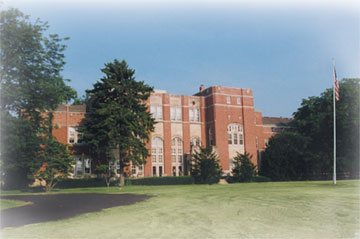 The Theosophical Society in America is a section of the worldwide Theosophical Society founded in New York in 1875 with its international headquarters at Adyar, Chennai (Madras), India. The American section has its national center in Wheaton, Illinois, on a beautiful estate called Olcott in honor of the American cofounder and first President of the Society, Colonel Henry Steel Olcott.
The Theosophical Society in America is a section of the worldwide Theosophical Society founded in New York in 1875 with its international headquarters at Adyar, Chennai (Madras), India. The American section has its national center in Wheaton, Illinois, on a beautiful estate called Olcott in honor of the American cofounder and first President of the Society, Colonel Henry Steel Olcott.
Olcott is the administrative headquarters of the Theosophical Society in America, but it is also a place where members and the public may participate in onsite courses, workshops, and retreats, or attend lectures and seminars on a wide variety of spiritual topics. It provides a summer convention for members in conjunction with the Society’s Annual Meeting, usually in July, at which prominent Theosophical students gather to learn from one another. A number of these programs have been recorded and are posted online for free viewing or listening (See the Online Resources menu).
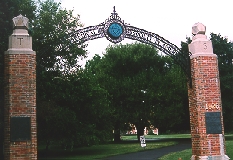
For the first fifty years of its history, the Society had its headquarters in various locations, according to the residence of its national presidents. In the mid 1920s, while L. W. Rogers was president of the American Section, the Wheaton site was selected. The property was purchased and continues to be maintained through the dues and gifts of members. In 1926 the cornerstone of the main building was laid by Annie Besant, second international President of the Society. This building was first occupied in 1927, and since that time has continued as the center of Theosophical work in the United States.
The main structure at Olcott is called the L. W. Rogers Building in honor of the national president in whose administration it was constructed. It looks out over a wide sweep of lawn toward the Main Street entrance gate, which has welcomed members and visitors since 1940. Designed by the eminent American architect, writer, and Theosophist, Claude Bragdon, the gate's pillars are capped by two of the five Platonic solids, symbolizing the order inherent in the universe.
The approach to the main entrance of the Rogers Building is the Ward walkway, a gently curving red-brick path, on either side of which are two contemporary sculptures from the collection of John and Anne Kern. Slant, a sculpture made of several varieties of stone, has a massive central panel of pietra serena ("serene stone") that seems to defy gravity by floating above the ground, matter rising to be spiritualized. Tantric Circle, a sculpture of patinated bronze and brass on a triple stone base, is a magical ring opening onto cosmic space.
 The two-story reception hall of the Rogers building is decorated on all four walls with striking murals depicting the advance of evolution. The murals were a gift of Mrs. C. Shillard Smith, who commissioned the Philadelphia artist, Richard Blossom Farley, to create a Theosophical sequence illustrating the unity of life through changing forms.
The two-story reception hall of the Rogers building is decorated on all four walls with striking murals depicting the advance of evolution. The murals were a gift of Mrs. C. Shillard Smith, who commissioned the Philadelphia artist, Richard Blossom Farley, to create a Theosophical sequence illustrating the unity of life through changing forms.
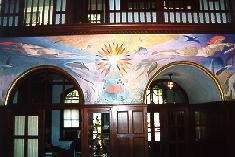 One side of the reception hall is flanked by french doors leading to a stone terrace, an inviting spot for conversation and contemplation of the vista of the front lawn and gardens. The other side of the hall has the Registrar's office with objects of art displayed in the cabinets on either side of its entrance. The Information desk is located on the south side of the reception hall.
One side of the reception hall is flanked by french doors leading to a stone terrace, an inviting spot for conversation and contemplation of the vista of the front lawn and gardens. The other side of the hall has the Registrar's office with objects of art displayed in the cabinets on either side of its entrance. The Information desk is located on the south side of the reception hall.
The elevator, which goes from basement to third floor, is located just up a few steps at the left of the reception hall. A corridor leads from the landing to the elevator. A lift (for wheel chairs) is also located in the reception hall-this makes the landing and elevator accessible to all. So all facilities in the Rogers building are now available to everyone, including three handicap-accessible restrooms.
The south corridor on the first floor of the main building contains portraits of the chief founders of the Society and its international presidents. Along this corridor are the classroom where many lectures and workshops take place and the administrative offices for the Department of Education and the accounting and financial offices. The mail room is also located on the corridor.
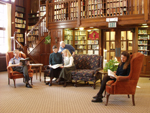 At the south end of the corridor is the entry to the two-story, paneled Henry S. Olcott Memorial Library. Containing more than 18,000 titles of books, periodicals, and audio and video cassettes, the library is a mecca for students and inquirers who come to browse or to borrow from its extensive collection of philosophical and religious literature. Off the library balcony above the book stacks and library offices are the National Archives, the Kern Room, and a rare-book room.
At the south end of the corridor is the entry to the two-story, paneled Henry S. Olcott Memorial Library. Containing more than 18,000 titles of books, periodicals, and audio and video cassettes, the library is a mecca for students and inquirers who come to browse or to borrow from its extensive collection of philosophical and religious literature. Off the library balcony above the book stacks and library offices are the National Archives, the Kern Room, and a rare-book room.
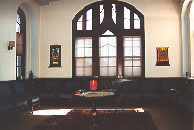 The stairs leading from the reception hall to the second floor open upon the central balcony of the main building. On the north side of that balcony is the Shrine Room, dedicated to meditation. Its hangings include a large portrait of H. P. Blavatsky painted by Gutzon Borglum. On most days during the week, the staff meet in this room to begin their day with a fifteen-minute meditation. The door closes, however, at 8:30 precisely, by the chimes of the reception-hall grandfather clock.
The stairs leading from the reception hall to the second floor open upon the central balcony of the main building. On the north side of that balcony is the Shrine Room, dedicated to meditation. Its hangings include a large portrait of H. P. Blavatsky painted by Gutzon Borglum. On most days during the week, the staff meet in this room to begin their day with a fifteen-minute meditation. The door closes, however, at 8:30 precisely, by the chimes of the reception-hall grandfather clock.
On either side of the hall leading from the balcony of the Shrine Room are two pastel paintings by Memphis artist Burton Callicott, Mandorla and Antahkarana, symbolizing the inner reality of the human being and our unity with all life. The second-floor balcony and south corridor lead to the office of the National President, the office of the National Secretary, and the Membership Office. A heroic-size bronze head of Annie Besant is prominent on the balcony. Along one wall of the corridor are displayed portraits of the past presidents of the American Section.
The stairs continue from the central balcony to the third-floor Olcott Gallery, which presents changing art exhibits with a spiritual theme. The gallery is also the anteroom to the main auditorium, used for public lectures as well as classes and other activities.
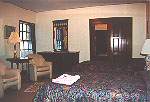
 The north wing of the main building, on all three floors, consists mainly of living quarters for the resident staff and guests. A living room with television for the use of resident staff and guests is located on the first floor.
The north wing of the main building, on all three floors, consists mainly of living quarters for the resident staff and guests. A living room with television for the use of resident staff and guests is located on the first floor.
A second major structure, on Geneva Road at the north side of the estate, is the Joy Mills Building, named for the national president in whose administration it was constructed. Completed in 1970, it accommodates the Theosophical Publishing House and the Quest Bookshop. The publishing house, whose chief imprint is Quest Books, provides traditional Theosophical literature, new works in the Theosophical tradition, and books of contemporary interest that are harmonious with a Theosophical worldview. The bookshop is the chief source of metaphysical and spiritual books in the Chicago area. The second floor of this building provides additional staff and guest quarters, and also houses the editorial, marketing, and publications offices of the publishing house. A large warehouse is located to the southwest of the Joy Mills building.
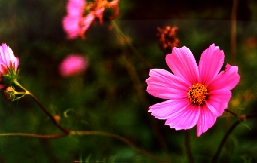 The forty acre estate also contains six separate residences, occupied by members of the staff. Garages, utility buildings, an apple orchard, a grape arbor, and an extensive vegetable garden are to the west of the private road that connects the main building and the publishing house. Throughout the grounds, stone benches invite the stroller to pause for meditation or to rest awhile.
The forty acre estate also contains six separate residences, occupied by members of the staff. Garages, utility buildings, an apple orchard, a grape arbor, and an extensive vegetable garden are to the west of the private road that connects the main building and the publishing house. Throughout the grounds, stone benches invite the stroller to pause for meditation or to rest awhile.
 The Perkins Pond on the south end of the estate is now home to families of ducks and Canadian geese. A recent project restored a western tract of the estate with native prairie grasses and flowers.
The Perkins Pond on the south end of the estate is now home to families of ducks and Canadian geese. A recent project restored a western tract of the estate with native prairie grasses and flowers.
The grounds include a number of memorial gardens and groves: Pierre Garden, given by Lillian Pierre; Besant Grove, commemorating the place Annie Besant stood to address the members on her last visit to the American Section in 1929; Aubrey Garden, given by Sidney A. Cook, a former National President of the American Section, in memory of his son; and Brother Raja Memorial Grove, honoring C. Jinarajadasa, fourth international President of the Society, who died at Olcott in 1953.
 Other memorial gardens include the L. W. Rogers Grove, in memory of that dynamic past president; the Sellon Grove, a gift of Captain Ernest M. Sellon, with a semicircle of stone benches in memory of Edward Paul Smith; and the Tony Balch Memorial Grove, a 1970 extension of the Besant Grove. Here and there about the estate are individual trees planted as memorials by families or friends of members who have passed on.
Other memorial gardens include the L. W. Rogers Grove, in memory of that dynamic past president; the Sellon Grove, a gift of Captain Ernest M. Sellon, with a semicircle of stone benches in memory of Edward Paul Smith; and the Tony Balch Memorial Grove, a 1970 extension of the Besant Grove. Here and there about the estate are individual trees planted as memorials by families or friends of members who have passed on.
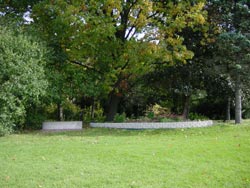 Halfway across the front lawn from the Rogers Building, a general Garden of Remembrance has been developed. It includes an ellipsoidal limestone bench on which visitors can sit, remember, and contemplate. Here is a quiet place to think of all those who have gone before us and to review our own lives. Amid the greenery and flowers is a statue of the gentle Saint Francis, for whom all beings were brothers and sisters. Meditation here can link us to the past, connect us with the living present, and direct us to a future of peace and harmony.
Halfway across the front lawn from the Rogers Building, a general Garden of Remembrance has been developed. It includes an ellipsoidal limestone bench on which visitors can sit, remember, and contemplate. Here is a quiet place to think of all those who have gone before us and to review our own lives. Amid the greenery and flowers is a statue of the gentle Saint Francis, for whom all beings were brothers and sisters. Meditation here can link us to the past, connect us with the living present, and direct us to a future of peace and harmony.
 Behind the Rogers Building, on the west side of the campus, is a seven-circuit Cretan labyrinth. Composed of large stepping stones on a field of pebbles, the labyrinth symbolizes the seven aspects of the cosmos and the human being. Walking its winding path from the circumference to the center and back out again represents the involution and evolution of the universe, the birth and passing from life of an individual, and a quest to the center of our being and subsequent return to our divine source. Many visitors come to Olcott to walk the labyrinth throughout the daylight hours, when the grounds are open.
Behind the Rogers Building, on the west side of the campus, is a seven-circuit Cretan labyrinth. Composed of large stepping stones on a field of pebbles, the labyrinth symbolizes the seven aspects of the cosmos and the human being. Walking its winding path from the circumference to the center and back out again represents the involution and evolution of the universe, the birth and passing from life of an individual, and a quest to the center of our being and subsequent return to our divine source. Many visitors come to Olcott to walk the labyrinth throughout the daylight hours, when the grounds are open.
The staff at Olcott consists of approximately fifty employees who carry on the work of the national center: educational, publishing (book, periodical, and audio-visual), and administrative. About a third of these employees are resident staff who also lead a community life, working and eating together and sharing in group activities. Some staff members are able to come to Olcott to serve on a permanent basis; others come for only a year or two. But all contribute to the unique life and work of this center of the Theosophical Society in America and share the experience of Theosophical community life.
Olcott is a busy center and a beautiful place. It provides a focal point for the energies and efforts of members throughout the American Section and coordinates the programs and activities of the Theosophical Society in America. Olcott is also the "Theosophical home" of every member of the American Section, a symbol of the aspiration and the commitment that brought it into being and that continue to sustain it as a place of wise inspiration, strength, and beauty.
The Theosophical Society's campus buildings are wheelchair accessible.
This short video was created and produced by Doug Fisichella who participated in a recent leadership conference (September 2010) held at the Olcott campus.
Enjoy this short video tour of Olcott, the national center of the Theosophical Society in America.

